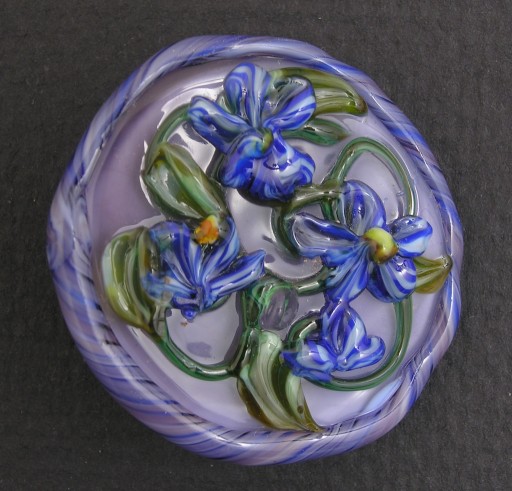This button perfectly illustrates two driving souces of “creativity”, at least for me:
- Using old crap up.
- Variations on a Theme.
No. 2., of course, is a venerable technique, often referred to as the ‘I wonder what would happen if’ game. For these buttons the progression in background color is obvious—I started with something very much within my comfort zone: since these are an experiment, and I have lots of this transparent red and opaque orange glass to use...when I finally got bored with that, then I cased a similar color, yellow, with blue, to get green; now, engaged with the idea of making these buttons in various colors, I switched to periwinkle blue cased in a medium transparent purple (this is one of those classic, can't-go-wrong color combos in the soft-glass world).
Meanwhile, to help tie the blue flowers to the orangey backgrounds, I put dots of center color—too wit, a candycorn cane. A what, you ask? Someday I'll have to document my efforts to make a witch after a wonderful Mavis Smith demo, but one of the ways she decorated her Halloween witches was with candycorn murrina. These are nearly as simple as they sound—shape a stack of orange, yellow and white glass into a tall triangle, round it out with clear colorless, pull and chop into little slices.
Except, even as simple as this cane was, mine came out totally stupid. As a candycorn cane, it's a total failure. As a center for blue flowers, though, I think it looks great. In fact, I came up with my leaf cane in almost exactly the same way: I had mounds of useless cane ends, and unwanted leftover pieces after making the complex cane for the GLBG commemorative bead. This cane was black symbols in yellow glass. Not wanting to throw all that glass away, and thinking the marbles I made with it were boring (that's Don Miller's trick for using up fancy cane ends) I started casing it with various greens. Much too my surprise, I discovered a) that the yellow and black (actually transparent dark purple) make brown and b) that yellows, browns and purple-blacks add real versimulatude vegetative greens.
I'm getting to the point some, um, 4 years later, that I'm finally running out of the commemorative scrap, but now, if I were to make leaf and stem cane from scratch I'd start with a black and yellow core—a perfect example of cheapness leading to serendipitous discovery. Since then I've discovered my favorite opaque greens to case are the striking mosaic and copper greens. (You can see the copper green as that lush, pale celadon looking color in the leaves, particularly the bottomost. Mosaic green has the fabulous habit of moving between a dark, almost black transparent and medium dark opaque malachite green, depending on how it's heated, and given the differential heat required for this sort cold-worked sculptural technique in order to keep the leaves crisp, it's an obvious choice.) But you can throw any combination of the various opaque (pea, petroleum, etc) greens on this yellow/black base, add some transparent greens and maybe a stripe or two of brown or black, and voila, wonderful, subtle leaf canes.
And now that I've finally started making the canes for a sig cane (that's next time) I've discovered that those (white) ends can be cased in blues and violets to make twisties—such as the one wrapping this button here. So you see, creativity is nothing more than a really cheap nature. Hence the scare quotes above:)
file created 11feb06
Unless otherwise noted, text, image and objects depicted therein copyright 1996--present sylvus tarn.
Sylvus Tarn